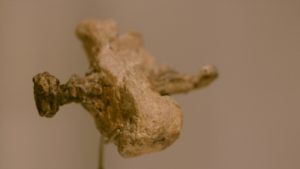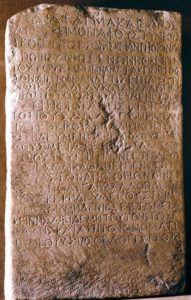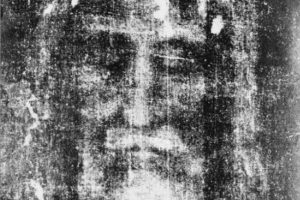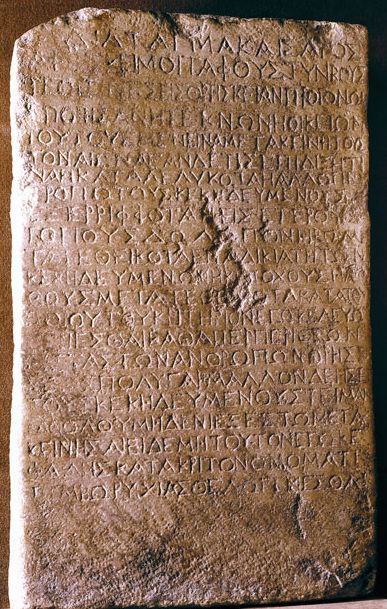By: Brian G. Chilton | April 13, 2021
Over the past few weeks, we have examined various lines of evidence that support the notion that Jesus literally rose from the dead. As we wrap up the series, it may prove beneficial to describe a few pieces of archaeological evidence that supports the resurrection of Jesus. Archaeological evidence can neither prove nor disprove an event of history.[1] However, it can lend itself to probabilities that an event did or did not occur. The resurrection poses an additional problem as no one was present when the event took place. Even still, certain artifacts lend credibility to the belief that Jesus rose from the dead.
The Nail Spiked Ankle Bone of Yehohannan
 In 1968, an ossuary was discovered that contained the heel bone of a young man named Yehohannan. Living 2,000 years ago, Yehohannan died by crucifixion at the hands of the Romans. Evidence suggests that he was only in his twenties when he died. The description of his crime has been lost to us. However, the nature of his execution was preserved by the young man’s extant heel bone. A traditional Roman spike pierced the heel of Yehohannan. But unlike other nails which were reused to crucify victims, this spike bent most likely after striking a knot in the wood. The heel bone, bent spike, and even a piece of wood confirm that nails were used, at least at times, to fasten victims to the cross. For Yehohannan, his executors nailed his ankles to the opposing exterior sides of the vertical beam rather than through the feet. The young man’s preserved heel bone reveals two things about Jesus’s death, burial, and resurrection.
In 1968, an ossuary was discovered that contained the heel bone of a young man named Yehohannan. Living 2,000 years ago, Yehohannan died by crucifixion at the hands of the Romans. Evidence suggests that he was only in his twenties when he died. The description of his crime has been lost to us. However, the nature of his execution was preserved by the young man’s extant heel bone. A traditional Roman spike pierced the heel of Yehohannan. But unlike other nails which were reused to crucify victims, this spike bent most likely after striking a knot in the wood. The heel bone, bent spike, and even a piece of wood confirm that nails were used, at least at times, to fasten victims to the cross. For Yehohannan, his executors nailed his ankles to the opposing exterior sides of the vertical beam rather than through the feet. The young man’s preserved heel bone reveals two things about Jesus’s death, burial, and resurrection.
First, the find proves that Romans did nail victims to the cross, confirming the details of the Gospel narratives related to the death of Jesus. Crucifixion was a nasty form of execution. The victim would slowly die from asphyxiation which led to heart failure. The chances of Jesus surviving crucifixion, as proposed by some, are slim to none.
Second, the find also proves that the Romans permitted families to grant crucified victims a proper burial. In ancient Israelite culture, a body was buried in a tomb. A year later, the bones were collected in the linen wrappings and placed in a common family ossuary (bone box). It was not until the time of Emperor Caligula that the practice of granting proper burial to crucified victims ceased. Caligula began his reign in AD 37 which was 4-7 years after the time of Jesus’s crucifixion and resurrection. Thus, the claim that Jesus was merely buried in a shallow grave rather than a tomb loses its impact in light of the discovery of Yehohannan’s heel bone.
Nazareth Decree
 The Nazareth Decree is a fascinating find. In 1878, a French scholar acquired a slab of stone in Nazareth dating to AD 44.[2] The decree was given by Emperor Claudius (AD 41-54) who charges that if anyone is found extracting or exhuming bodies from tombs, then the graverobbers would be charged and promptly executed. Interestingly, the decree also mentions one moving stones enclosing tombs. The Gospel of Matthew notes that the Jewish leaders deceitfully contrived a rumor that the disciples had stolen the body of Jesus (Matt. 28:11-15). While a direct correlation cannot be drawn between the Nazareth Decree and the rumor arranged by the Jewish Sanhedrin, one still finds a strong probability that the growth of Christianity accompanied with the rumor could have necessitated such a decree in the emperor’s mind.[3]
The Nazareth Decree is a fascinating find. In 1878, a French scholar acquired a slab of stone in Nazareth dating to AD 44.[2] The decree was given by Emperor Claudius (AD 41-54) who charges that if anyone is found extracting or exhuming bodies from tombs, then the graverobbers would be charged and promptly executed. Interestingly, the decree also mentions one moving stones enclosing tombs. The Gospel of Matthew notes that the Jewish leaders deceitfully contrived a rumor that the disciples had stolen the body of Jesus (Matt. 28:11-15). While a direct correlation cannot be drawn between the Nazareth Decree and the rumor arranged by the Jewish Sanhedrin, one still finds a strong probability that the growth of Christianity accompanied with the rumor could have necessitated such a decree in the emperor’s mind.[3]
Church of the Holy Sepulchre
 Protestants often prefer the serene location of Gordon’s Tomb over the iconic and liturgical nature of the Church of the Holy Sepulchre. However, if one pursues truth over preference, the Church of the Holy Sepulchre is hands-down far more likely to be the actual tomb of Jesus rather than the irenic counterpart. In AD 132, Emperor Hadrian barred Jews from Jerusalem and attempted to eradicate evidence of both Judaism and Christianity by building Roman temples and statues over sacred spots. In AD 313, Constantine legalized Christianity. His mother Helena, a devout Christian, sought to discover the most sacred sites of Christianity. Hadrian had placed a statue of Venus atop the tomb of Christ in an effort to desecrate the tomb. When Helena asked local believers where the tomb was located, they pointed her to the tomb with the erected Venusian statue. Helena immediately ordered the removal of the statue and the preservation of the tomb. The Church of the Holy Sepulchre was later built around the tomb and crucifixion site. A few years ago, in an effort to restore key sections of the holy church, researchers were allowed to peer inside the slab of marble used to protect the bedding. The upper part was removed. Underneath, they discovered a broken piece of metal with a Crusader’s cross engraved. Under the metal, they found a stone bedding that dated to the first century. The discovery proved that the Edicule of the Church of the Holy Sepulchre has been revered as the burial place of Christ for two millennia. This adds considerable weight to the idea that the empty tomb of Jesus is either in the Edicule or very nearby. Personally, the Edicule holds a strong probability of being the actual burial site of Jesus—a probability greater than 95%.
Protestants often prefer the serene location of Gordon’s Tomb over the iconic and liturgical nature of the Church of the Holy Sepulchre. However, if one pursues truth over preference, the Church of the Holy Sepulchre is hands-down far more likely to be the actual tomb of Jesus rather than the irenic counterpart. In AD 132, Emperor Hadrian barred Jews from Jerusalem and attempted to eradicate evidence of both Judaism and Christianity by building Roman temples and statues over sacred spots. In AD 313, Constantine legalized Christianity. His mother Helena, a devout Christian, sought to discover the most sacred sites of Christianity. Hadrian had placed a statue of Venus atop the tomb of Christ in an effort to desecrate the tomb. When Helena asked local believers where the tomb was located, they pointed her to the tomb with the erected Venusian statue. Helena immediately ordered the removal of the statue and the preservation of the tomb. The Church of the Holy Sepulchre was later built around the tomb and crucifixion site. A few years ago, in an effort to restore key sections of the holy church, researchers were allowed to peer inside the slab of marble used to protect the bedding. The upper part was removed. Underneath, they discovered a broken piece of metal with a Crusader’s cross engraved. Under the metal, they found a stone bedding that dated to the first century. The discovery proved that the Edicule of the Church of the Holy Sepulchre has been revered as the burial place of Christ for two millennia. This adds considerable weight to the idea that the empty tomb of Jesus is either in the Edicule or very nearby. Personally, the Edicule holds a strong probability of being the actual burial site of Jesus—a probability greater than 95%.
Shroud of Turin
 Finally, we end with one of the most mysterious archaeological finds of all time. Just when skeptics seem to debunk the Shroud of Turin, something comes along that later confirms it. The Shroud of Turin is a highly controversial linen cloth that measures 14 feet, 5 inches by 3 feet, 7 inches. It bears a negative three-dimensional image of a crucified man in his thirties and includes bloodstains of actual AB hemoglobin.[4] Additional discoveries have found pollen grains of plants based in Israel and dating to the first century along with evidence that the Shroud had been exposed to a high dose of radiation, perhaps from the resurrection event itself.[5] Although the Shroud had been dated to the medieval ages in a carbon-14 test conducted in 1988, those tests have proven false. The debate surrounding the Shroud of Turin will most certainly continue until the return of Christ himself. The Shroud of Turin is not necessary to prove that Jesus rose from the dead, as has been shown by this series. Nonetheless, if the Shroud of Turin is authentic, it not only proves that Jesus rose from the dead, but it also provides a snapshot as to how Jesus may have looked.
Finally, we end with one of the most mysterious archaeological finds of all time. Just when skeptics seem to debunk the Shroud of Turin, something comes along that later confirms it. The Shroud of Turin is a highly controversial linen cloth that measures 14 feet, 5 inches by 3 feet, 7 inches. It bears a negative three-dimensional image of a crucified man in his thirties and includes bloodstains of actual AB hemoglobin.[4] Additional discoveries have found pollen grains of plants based in Israel and dating to the first century along with evidence that the Shroud had been exposed to a high dose of radiation, perhaps from the resurrection event itself.[5] Although the Shroud had been dated to the medieval ages in a carbon-14 test conducted in 1988, those tests have proven false. The debate surrounding the Shroud of Turin will most certainly continue until the return of Christ himself. The Shroud of Turin is not necessary to prove that Jesus rose from the dead, as has been shown by this series. Nonetheless, if the Shroud of Turin is authentic, it not only proves that Jesus rose from the dead, but it also provides a snapshot as to how Jesus may have looked.
Conclusion
Admittedly, the archaeological evidence for the resurrection of Jesus is largely circumstantial. The only direct piece of archaeological evidence for the resurrection would be the Shroud of Turin, if genuine. However, the Shroud is enshrouded in mystery (pun intended). Because of the nature of the resurrection event, one should not expect a slam dunk discovery to be made. Why? Because Jesus is no longer in the tomb. The most direct evidence has been removed and is no longer available. Regardless, the data provided when taken together affords a strong case that something mysterious and amazing transpired on the first Easter Sunday. The artifacts described prove the high probability that Jesus died by crucifixion, was buried in a tomb, the tomb was found empty, and that the tomb was revered for two millennia. Taken together, that is a compelling case for the resurrection event. For more information on the archaeological evidence for the Bible, see chapter 13 of the Layman’s Manual on Christian Apologetics, and be sure to check out Ted Wright’s page EpicArchaeology.com.
About the Author
Brian G. Chilton is the founder of BellatorChristi.com, the host of The Bellator Christi Podcast, and the author of the Layman’s Manual on Christian Apologetics. Brian is a Ph.D. Candidate of the Theology and Apologetics program at Liberty University. He received his Master of Divinity in Theology from Liberty University (with high distinction); his Bachelor of Science in Religious Studies and Philosophy from Gardner-Webb University (with honors); and received certification in Christian Apologetics from Biola University. Brian is enrolled in the Ph.D. program in Theology and Apologetics at Liberty University and is a member of the Evangelical Theological Society and the Evangelical Philosophical Society. Brian has served in pastoral ministry for nearly 20 years. He currently serves as a clinical chaplain.
https://www.amazon.com/Laymans-Manual-Christian-Apologetics-Essentials/dp/1532697104
Notes
[1] Randall Price and H. Wayne House, Zondervan Handbook of Biblical Archaeology, 26.
[2] Norman L. Geisler, Baker Encyclopedia of Christian Apologetics, 48; Ted Wright, “10 Significant NT Archaeological Discoveries,” EpicArchaeology.com.
[3] To read the full transcript of the Nazareth Decree, see Brian G. Chilton, Layman’s Manual on Christian Apologetics, 123.
[4] Chilton, Layman’s Manual on Christian Apologetics, 127-128.
[5] Ibid., 128.
© 2021. BellatorChristi.com.






[…] Source: Resurrection Defense Series (Part Seven): Archaeological Evidences Supporting the Resurrection […]